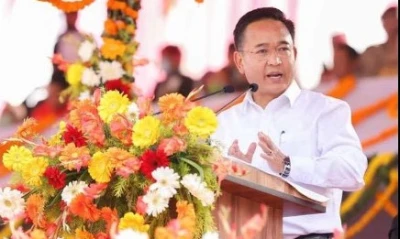Sikkim Chief Minister Prem Singh Tamang announced the restoration of the Old Pension System or OPS for the State Government employees appointed on or after April 1, 2006, making it the first State in the Northeast to reinstate this system. On the other hand, The Assam Government is engaged in talks with employees demanding the restoration of the OPS, said Parliamentary Affairs Minister Pijush Hazarika.
The decision, originating from the provisions of the Sikkim Services (Pension) Rules of 1990, aspires to benefit employees appointed on or before March 31, 1990, reinstating guidelines governing the modalities of the pension system.
It was among a series of welfare measures launched to improve the lives of the people of Sikkim during the State Level Temporary Employees’ Convention held at Public Ground Rangpo on February 9.
Key among the announced schemes is the amendment to the Sikkim Government policies concerning the regularization of temporary employees. As per the latest notification from the Personnel Department, the services of temporary employees with benchmark disabilities, serving continuously for two years or more in a specific post, may now be considered for regularization within their respective departments.
In another pivotal reform, the government revised its previous notification regarding the regularization of temporary employees. Under the updated clause, services of temporary employees serving continuously for four years or more in various capacities, including work-charged, muster roll, adhoc, and consolidated pay, may now be eligible for regularisation.
Meanwhile, Assam Minister Pijush Hazarika explained the NPS was developed based on the provisions outlined in the OPS and includes features such as gratuity payment and family pension, mirroring those available under the OPS.
The minister clarified that under the NPS, at least 10 per cent of an employee’s basic salary and dearness allowance are allocated to the pension fund, with the government aligning with this contribution. Upon retirement, an employee receives 60 per cent of the accrued amount, with the remaining 40 per cent used to purchase an annuity, ensuring a steady pension income.
Hazarika noted individuals with approximately 30 to 32 years of remaining service stand to gain from the NPS, while those with shorter tenures may encounter challenges.
The OPS that assured life-long income, post-retirement, usually equivalent to 50 per cent of the last drawn salary, was discontinued in 2004. The government bears the expenditure incurred on the pension under the OPS.
The Narendra Modi Government had constituted a four-member committee led by the Finance Secretary to “look into the issue of pensions under the National Pension System or NPS in respect of government employees and evolve an approach which addresses the needs of the employees while maintaining fiscal prudence to protect the common citizens” last April.

















